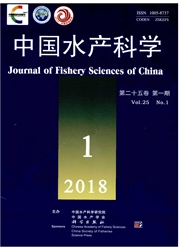

 中文摘要:
中文摘要:
采用鳗鲡源嗜水气单胞菌(Aeromonas hydrophila)和迟缓爱德华氏菌(Edwardsiella tarda)外膜蛋白基因二联表达产物免疫日本鳗鲡(Anguilla japonica),检测其对日本鳗鲡免疫功能的影响及其攻毒免疫保护力。将150尾日本鳗鲡平均分为PBS、细菌免疫和外膜蛋白免疫3个组,3组鳗鲡分别以PBS(0.01 mol/L, pH7.4)、嗜水气单胞菌与迟缓爱德华氏菌二联灭活苗(5.0×108 CFU/mL)、嗜水气单胞菌与迟缓爱德华氏菌外膜蛋白二联表达产物(500μg/mL)腹腔注射0.2 mL。于免疫后14、21和28 d麻醉鳗鲡采血并分离抗凝血。测定3个时间点鳗鲡血浆中特异性抗体效价和同时期鳗鲡血浆、体表黏液、肝和肾组织匀浆液中的溶菌酶含量,同时检测3个时间点鳗鲡全血细胞的转化水平。免疫后28 d,嗜水气单胞菌和迟缓爱德华氏菌分别腹腔注射感染3组鳗鲡并测定其相对免疫保护率。结果表明,免疫后14 d和28 d,灭活菌和外膜蛋白免疫组的抗体水平均极显著高于PBS组(P〈0.01)。溶菌酶检测结果表明,不同处理组不同时间段血清、黏液和肝肾组织悬液的溶菌酶含量存在显著(P〈0.05)或极显著(P〈0.01)差异。免疫后14 d 灭活菌组全血细胞转化水平显著高于 PBS 和外膜蛋白组(P〈0.05),而21 d 两个免疫组则均显著低于PBS组(P〈0.05)。活菌感染结果表明,灭活菌和外膜蛋白免疫后28 d对两株病原菌的攻毒相对免疫保护率均比PBS组提高了50%(P〈0.05)。本研究结果表明鳗鲡源嗜水气单胞菌和迟缓爱德华氏菌外膜蛋白二联表达产物免疫日本鳗鲡后可提高鳗鲡的免疫功能及其对这两株菌的抵抗力,从而可能应用于鳗鲡基因工程疫苗的研发。
 英文摘要:
英文摘要:
The immune responses and vaccine protection levels in Japanese eels (Anguilla japonica) were evaluated after they were immunized with a bivalently-expressed outer membrane protein (OMP) of porin II and ompS2 from Aeromonas hydrophila and Edwardsiella tarda, respectively. One-hundred and fifty eels distributed into three equal groups were administered intraperitoneal (i.p) injections of phosphate-buffered saline (PBS group), formalin-killed whole cells from A. hydrophila and E. tarda (FKC group), or bivalent OMP (OMP group). The plasma collected on days 14, 21 and 28 were used to measure the titers of specific antibodies and lysozyme activity, and whole blood cells col-lected on these days were used to evaluate the stimulation index (SI). Lysozyme activities in skin mucus and suspen-sions of liver and kidney were also recorded on these days. On day 28 post-immunization, eels from all three groups were challenged by i.p injection of live A. hydrophila or E. tarda. Compared with the PBS group, the serum titers of the anti-A. hydrophila and anti-E. tarda antibodies in the FKC and OMP group eels were significantly higher (P〈0.01) on days 21 and 28. Compared with the PBS and OMP groups, proliferation of whole blood cells in the FKC group was significantly (P〈0.05) enhanced on day 14, but whole blood cell proliferation in the two immunized groups signifi-cantly (P〈0.05) decreased on day 21 compared with the PBS group. Lysozyme activity in serum, skin mucus, and the liver and kidney suspensions differed significantly (P〈0.05 or P〈0.01) between the three groups. The relative percent-age survival after challenge with A. hydrophila or E. tarda on day 28 post-immunization in the two vaccinated groups vs. the PBS group was 50%(P〈0.05). These results show that bivalent OMP improved the immune function of the Japanese eel and protected it against infection with A. hydrophila and E. tarda. This vaccine has potential for use in freshwater farmed eels.
 同期刊论文项目
同期刊论文项目
 同项目期刊论文
同项目期刊论文
 期刊信息
期刊信息
